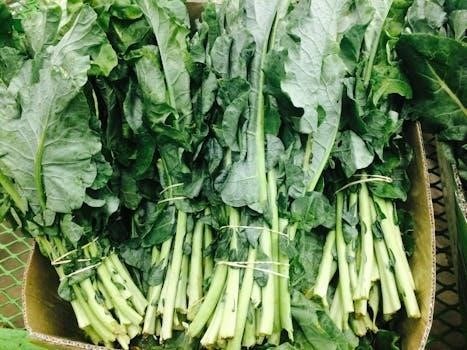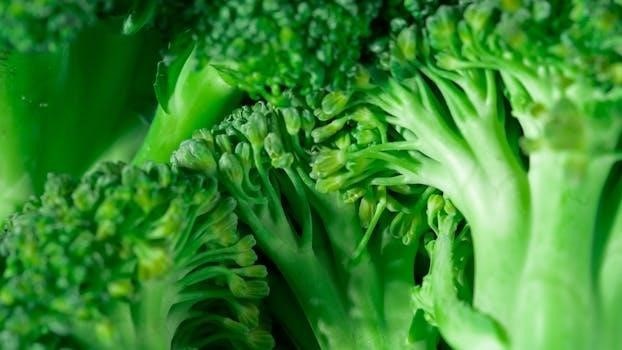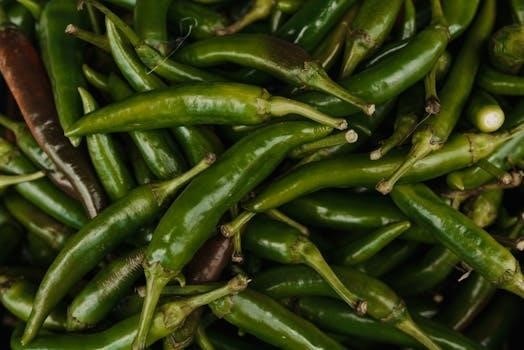
Understanding Plant-Based Diets
Plant-based diets focus on foods derived from plants, including fruits, vegetables, grains, legumes, nuts, and seeds. These diets can vary, from vegan to vegetarian, emphasizing whole, unprocessed plant foods. These dietary choices often exclude or limit animal products for health and ethical reasons.
Defining a Plant-Based Diet
A plant-based diet primarily revolves around consuming foods derived from plants. This encompasses a wide range of options, from fruits and vegetables to grains, legumes, nuts, and seeds. While often associated with veganism and vegetarianism, a plant-based approach can also include flexitarian eating patterns where animal products are minimized. The core principle is to prioritize whole, unprocessed plant foods, focusing on their natural state with minimal refining. This may involve avoiding or reducing the intake of animal-derived products such as meat, dairy, eggs, and honey. The emphasis is on nutrient-rich plant sources to support overall health and well-being. It is a flexible approach that allows for individual preferences and nutritional needs, centered on the power of plants.
Benefits of a Plant-Based Diet
Adopting a plant-based diet offers numerous health advantages. These diets are often rich in fiber, vitamins, minerals, and antioxidants, which can contribute to improved digestive health and reduced risk of chronic diseases. Plant-based eating can support healthy weight management due to the lower calorie density and higher fiber content of plant foods. Furthermore, this dietary approach can help regulate blood sugar levels and improve heart health by lowering cholesterol and blood pressure. Many people find that plant-based diets lead to increased energy levels and a general sense of well-being. The focus on whole foods also reduces the intake of processed items, promoting a more nutrient-rich and balanced diet. These benefits make a plant-based diet a powerful tool for overall health and longevity.

Creating a Plant-Based Grocery List
Developing a plant-based grocery list is essential for successful meal planning. This list should prioritize whole, unprocessed foods and include items from all plant-based food groups to ensure a balanced diet.
Importance of a Shopping List
A well-structured shopping list is paramount for maintaining a successful plant-based diet. It acts as a roadmap, guiding your purchases and preventing impulse buys that may not align with your dietary goals. Utilizing a list saves time and money by ensuring you only purchase necessary items, minimizing food waste. Moreover, a shopping list helps in planning balanced meals, making sure you include a variety of fruits, vegetables, grains, legumes, nuts, and seeds. This pre-planning reduces the chances of opting for less healthy, convenient options. It provides structure to your grocery trips and makes the task less overwhelming. By having a prepared list, you can avoid the common pitfall of forgetting essential ingredients, which can derail your plant-based meal plans. This also helps you stay focused on whole foods, and also helps you identify any sneaky non-vegan ingredients or animal derived products that might be included in your diet. Ultimately, a shopping list is a key tool for consistency and success.
Focus on Whole Foods
When creating a plant-based grocery list, prioritizing whole foods is essential for optimal health and nutrition. Whole foods are those that are minimally processed and remain in their natural state, such as fresh fruits, vegetables, whole grains, legumes, nuts, and seeds. These foods are packed with vitamins, minerals, fiber, and antioxidants, which are vital for maintaining overall wellness. Shifting the focus to whole foods helps to avoid the pitfalls of processed and packaged foods, which often contain high levels of unhealthy fats, sugars, and sodium. They provide sustained energy and promote better digestion, supporting a more balanced diet. Embracing whole foods ensures you are getting the full nutritional benefits from your plant-based choices. This approach can often help lower grocery bills when you buy from scratch, and also reduces the chances of consuming hidden animal ingredients. It also helps you avoid the common pitfall of relying on ultra-processed foods.
Printable List Options
Having a printable plant-based grocery list can greatly simplify your shopping experience, offering a structured approach to ensure you don’t miss any essential items. Many websites and blogs provide free, downloadable PDF templates that you can easily print at home. These lists often include categories for fruits, vegetables, grains, legumes, nuts, seeds, and plant-based alternatives, helping you stay organized. Some printable lists are even customizable, allowing you to add or remove items based on your preferences and dietary needs. Utilizing these options saves time and reduces the stress of grocery shopping, particularly for those new to plant-based diets. Furthermore, these lists often include blank spaces for you to add other items, making them more versatile. A printable list also makes it easy to keep track of your needs and helps you stick to your plant-based goals, both in terms of health and budget.

Key Food Groups for Plant-Based Diets
Plant-based diets emphasize fruits, vegetables, grains, legumes, nuts, and seeds. These groups provide essential nutrients like fiber, vitamins, and minerals. Focusing on these diverse foods is important for a balanced diet.
Fruits and Vegetables
Fruits and vegetables are foundational to any plant-based diet, offering a wide array of vitamins, minerals, and antioxidants. They are versatile and can be enjoyed in numerous ways, from fresh snacks to key ingredients in meals. Focus on seasonal produce for optimal flavor and nutritional value. Incorporate a variety of colors to ensure a diverse intake of phytonutrients. Frozen fruits and vegetables are excellent alternatives, as they are picked at peak ripeness and retain their nutrients. Canned options can be convenient but be mindful of added sugars and salt. These foods are essential for a balanced and nutritious plant-based eating plan. Add as many as you can to your diet. Enjoy!
Grains and Legumes
Grains and legumes form a crucial part of a plant-based diet, providing essential carbohydrates, protein, and fiber. Whole grains, like brown rice and quinoa, offer sustained energy and are nutrient-rich. Legumes, including beans, lentils, and peas, are excellent sources of plant-based protein and fiber, vital for satiety and digestion. They can be used in various dishes, from soups to salads. Canned legumes offer convenience, but cooking them from scratch can reduce costs. Aim for a balance of both low and high fiber options in your diet. These foods are versatile and can be incorporated into any meal. These are important in keeping you full and energized.
Nuts and Seeds
Nuts and seeds are nutritional powerhouses, offering a wealth of protein, healthy fats, minerals, and vitamins, making them essential for a balanced plant-based diet. These versatile foods can be incorporated into various meals and snacks, such as sprinkled on salads, added to oatmeal, blended into smoothies, or used to create plant-based milk and coffee creamers. They contribute healthy fats that support overall well-being. Consider a variety of nuts and seeds to maximize the range of nutrients you receive. These small additions can significantly boost the nutritional value of any meal. They also provide a satisfying crunch and texture. Incorporating a mix of these into your diet will help to diversify your nutrient intake.

Plant-Based Alternatives and Pantry Staples
This section explores dairy and meat substitutes, essential condiments and spices, and convenient frozen and canned options. These items are crucial for creating diverse and flavorful plant-based meals and stocking a well-prepared pantry.
Dairy and Meat Substitutes
Exploring the realm of plant-based alternatives opens up a world of possibilities, allowing you to enjoy familiar flavors and textures without animal products. Dairy substitutes, such as almond, soy, oat, and rice milk, offer diverse options for beverages and cooking. Many brands provide fortified versions to ensure you get vital nutrients like calcium and vitamin D. Vegan cheeses, crafted from nuts, soy, or other plant sources, come in various styles, from slices to shreds, catering to different culinary needs. For meat replacements, tofu, tempeh, and seitan are versatile choices. Additionally, the market is abundant with prepared vegan meats, including burgers, sausages, and crumbles from brands like Tofurky and Beyond Meat, offering a range of flavors and textures to satisfy cravings. These substitutes allow for easy transitions and exciting creations in plant-based cooking. These options greatly aid in transitioning to a plant-based diet.
Condiments and Spices
Enhancing the flavors of plant-based meals is made easy with a wide array of vegan-friendly condiments and spices. Stocking your pantry with basics like salt, pepper, garlic powder, onion powder, and paprika is essential. Explore the world of herbs such as oregano, basil, thyme, and rosemary to add depth to your dishes. Sauces like soy sauce, tamari, hot sauce, and mustard provide tangy and savory notes. Consider incorporating vinegar, such as apple cider or balsamic, for acidity. Don’t forget about nutritional yeast, which can add a cheesy flavor to various foods. Remember to check labels for hidden animal products in pre-made condiments like some curry pastes which can contain shrimp. With the right spices and sauces, any plant-based meal can become a culinary delight. Experimenting with different flavor combinations can be a fun and rewarding experience, enriching your plant-based diet journey.
Frozen and Canned Options
Frozen and canned foods are convenient and nutritious additions to a plant-based pantry. Frozen fruits and vegetables are picked at peak ripeness, preserving their nutrients and offering a great way to reduce food waste. Having a variety of frozen options like berries, spinach, and mixed vegetables on hand is perfect for quick meals and smoothies. Canned vegetables, such as beans, lentils, and tomatoes, are budget-friendly staples that can be used in many dishes. Be sure to check labels carefully for any added sugar, salt, or non-vegan ingredients like butter. Canned fruits can be a great option, but watch out for added sugars, opting for those packed in water or their own juice. These pantry staples make it easier to prepare healthy plant-based meals quickly, even when fresh produce isn’t available. They offer great solutions for meal prep and emergency meals.
Shopping Tips and Considerations
When shopping, consider your budget and seasonal produce for cost-effectiveness. Always read labels to avoid hidden animal ingredients. Plan your meals to make shopping easier and more efficient, and check for vegan certifications.
Budgeting and Seasonality
Adopting a plant-based diet doesn’t have to break the bank. Focusing on seasonal produce is a great way to save money, as fruits and vegetables are often cheaper when they are in season locally. Planning your meals around what’s currently available can lead to significant cost reductions. Buying in bulk, especially for staples like grains and legumes, can also lower your overall grocery bill. Additionally, cooking from scratch, rather than relying on pre-made or processed plant-based alternatives, tends to be more economical. Remember that frozen fruits and vegetables are just as nutritious as fresh, and they often come at a lower price point. Utilize canned goods wisely, but be mindful of added salt or sugar. By embracing smart shopping habits and taking advantage of nature’s cycles, you can maintain a healthy plant-based diet while sticking to your budget.
Reading Labels Carefully
Navigating the grocery store as a plant-based eater requires diligent label reading. It’s crucial to check for hidden animal-derived ingredients, which can be present in unexpected places. Look out for things like whey, casein, gelatin, and honey, which are commonly used in processed foods. Pay close attention to the ingredients list, rather than relying solely on front-of-package marketing claims. Be aware that some products may be labeled as “vegetarian” but still contain dairy or eggs, so it’s essential to verify that they are truly plant-based. Familiarize yourself with common non-vegan additives and become proficient in identifying them. Don’t hesitate to research ingredients you’re unsure about, as knowledge is your best tool for avoiding unwanted animal products. This mindful approach will ensure you make informed choices aligned with your plant-based goals.
Avoiding Hidden Animal Ingredients
One of the trickiest aspects of maintaining a plant-based diet is identifying and avoiding hidden animal ingredients. Many processed foods contain sneaky non-vegan components that are not always obvious. Common culprits include whey, casein, gelatin, and honey, often found in things like breads, sauces, and even some vegetable products. Always scrutinize ingredient lists for these and other less-obvious additives such as carmine (a red food coloring derived from insects) or shellac. Be wary of generic terms like “natural flavoring,” which can sometimes mask animal-derived substances. Research unfamiliar ingredients and don’t be afraid to contact manufacturers for clarification. Developing a habit of thorough label-reading will help you confidently navigate the grocery store and avoid unknowingly consuming animal products. This vigilance is key to fully embracing a plant-based lifestyle.
